06 | BIO FABRICATING MATERIALS¶
This week evolved around bio-fabricating material using waste products and naturally- and locally sourced materials to create textiles, membranes, leathers and plastics.
RESEARCH | IDEATION¶
I have since my many investigations into seaweed been interested in naturally sourced materials, where we use what we can find locally to create alternative materials. A huge inspiration for me has been Julia Lohmann whom I have both interned with and worked with. Her philosophy is designing with an ecocentric perspective, instead of a human-centric one. This concept involves collaborating across disciplines and sciences to understand the impacts and outputs of the design process, product and waste. In other words enabling the design to be intended for and in sync with the ecosystem, not for merely the humans in it. This way of viewing the design process and circularity corresponds to what they are trying to work towards in the Fabricademy. This course calls our focus on why we have to alter our way of consuming, using and designing.
The concept of bio materials is a slippery slope to go out on, as it can be divided into many categories and describe many things, and just because there is a "Bio" in front of something it does not mean it is necessarily compostable or just thrown out in nature. Some good terms to have defined are Bio-Based, Bio-Degradable and Bio-Compostable. Bio-based material is material that is based on natural material such as bacterial, fungal, animal, mineral and biosynthetic. Biodegradable are materials that are degraded in specific conditions, either by pH, enzymes or thermal processes. Bio-compostable are materials that are degraded within 90 days, this can be bacteria, mycelium, animal etc. When we work with bio materials we talk about different types of materials, which can either be grown or fabricated, the grown are root-fabrics, fungal leathers and spider silks, whereas the fabricated ones are plastics, foams, resins, silicone, fruit leathers and yarns.
My approach to this week has been looking into designers working with seaweed but also using their local environment to solve problems for their local environment. My favourite example is Ari Jónsson's algae water bottle from 2016, and also the very first piece of design that made me fully aware that it is possible to design something beautiful and bio-compostable at the same time. Another designer working with seaweed and algae is Jasmin Lighton with her collection Seaweed Girl, where she uses alginate and seaweed as sequins in her woven fashion pieces. Being from Denmark I have a certain predilection for seaweed as it covers our shores, but another plant which is even more present along our shores are the eelgrass, which we for generations have used for roofs and filling materials. A recent project made with eelgrass is the Seaweed House commissioned by Realdania and Vankunsten, who based on the old danish techniques created a eelgrass facade. This way of working with local materials are very inspiring, especially as the eelgrass can in too large amounts can suffocate the ecosystems at the coasts so it gets a new life by being used in these contexts. Another designer working with locally sourced material is Romy Kaiser with her keratin bio-plastics made from human hair. I donated my own hair to her master thesis.
Another aspect I am also interested in is the concept of degradable scenography and costume design. This is a concept explored by Catherine Euale who works with algae, kombucha and mycelium to create the Planet-centric design and material proposals, especially focusing on costumes. The costumes of a performance are only used in a specific amount of time and then discarded or forgotten about in a storage, the idea is to create costumes that can be degraded after use, thereby giving nutrition back to nature without accumulating waste. I have been interested in scenography and costume design for a long time as the meeting of material, human, movement, light and sound is an amazing forum to work within, creating worlds that stimulate and challenge the mind and imagination.
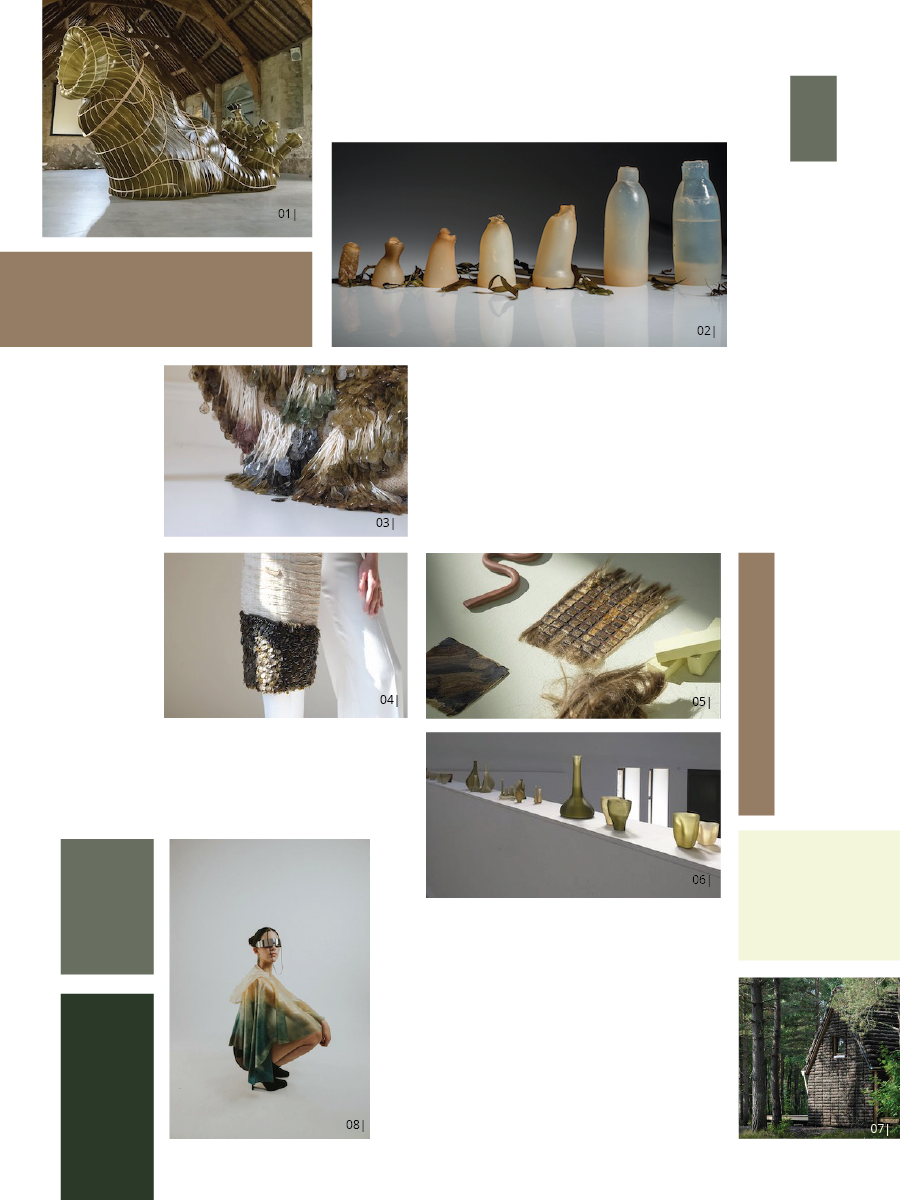
- 01| KOMBU NUDIBRANCH, 2022, JULIA LOHMANN
- 02| BOTTLE, 2016, ARI JÓNSSON
- 03| SEAWEED GIRL, 2019, JASMIN LIGHTON
- 04| SEAWEED GIRL, 2019, JASMIN LIGHTON
- 05| KREATIN, 2020, ROMY KAISER
- 06| 3D PRINTED BIOPOLYMERS, 2018, ERIK KLARENBEEK AND MAARTJE DROS
- 07| MODERN SEAWEED HOUSE, 2013, VADNKUNSTEN
- 08| FUTURE WARDROBE, 2021, CATHRINE EUALE
FABRICADEMY SOURCES:
- BEATRIZ SANDINI TextileLab Amsterdam 2019-20
- CAROLINA DELGADO TextileLab Amsterdam 2019-20
- HANNA OLOLADE FabTextiles Barcelona 2021-22
- PETRA GARAIOVÁ FabTextiles Barcelona 2021-22
- EDUARDO LORETO Basque Design Center 2021-22
- OLATZ PEDERA Basque Design Center 2021-22
TUTORIALS¶
TOOLS¶
- SCALES
- POTS
- JARS
- SPOON
- TONG
- MEASURING
- MOLDS
- TEXTILES
- EMBROIDERY HOOPS
- LEFTOVER PLASTICS
- PLY-WOOD FOR LASERCUT MOLDS
- DRYING CABINET
PROCESS | WORKFLOW¶

- 01| SAMPLES OF GELATINE AND AGAR MATERIALS, PHOTO BY ALBERTE BOJESEN
This week has been amazing as I was able to properly learn the different processes of fabricating bio-plastics, foils, solicons and resins. I have previously worked a lot with fabricating seaweed paper only using water, seaweed and glycerol, so being able to learn the different processes from the bottom has been very exciting. This week's work has been a team effort, trying out as many recipes as possible to create a collective material library. By doing this we were able to help and inspire each other but also extend the research to a variety of materials such as hops, fish scales, seaweed, sand and sheep stomachs from the local butchery. Most of the filler materials we used, have been locally sourced by talking to breweries, the fish leather factory and the local slaughterhouse. Much of the networking was done by our local material pusher Emma Shannon. The seaweed and the sand was collected on our beach. The result of this week has been our material recipe book The Icelandic Bio-Material Chronicles where we have process, recipe, tools, tips and evaluation of the resultant material. This evaluation was done at the last day of the week where we collectively evaluated the materials and shared our knowledge, an aspect which was really giving as it was a fantastic way of sharing knowledge and debriefing the week. My personal result was to create locally sourced bio materials and learn about the basic recipes.
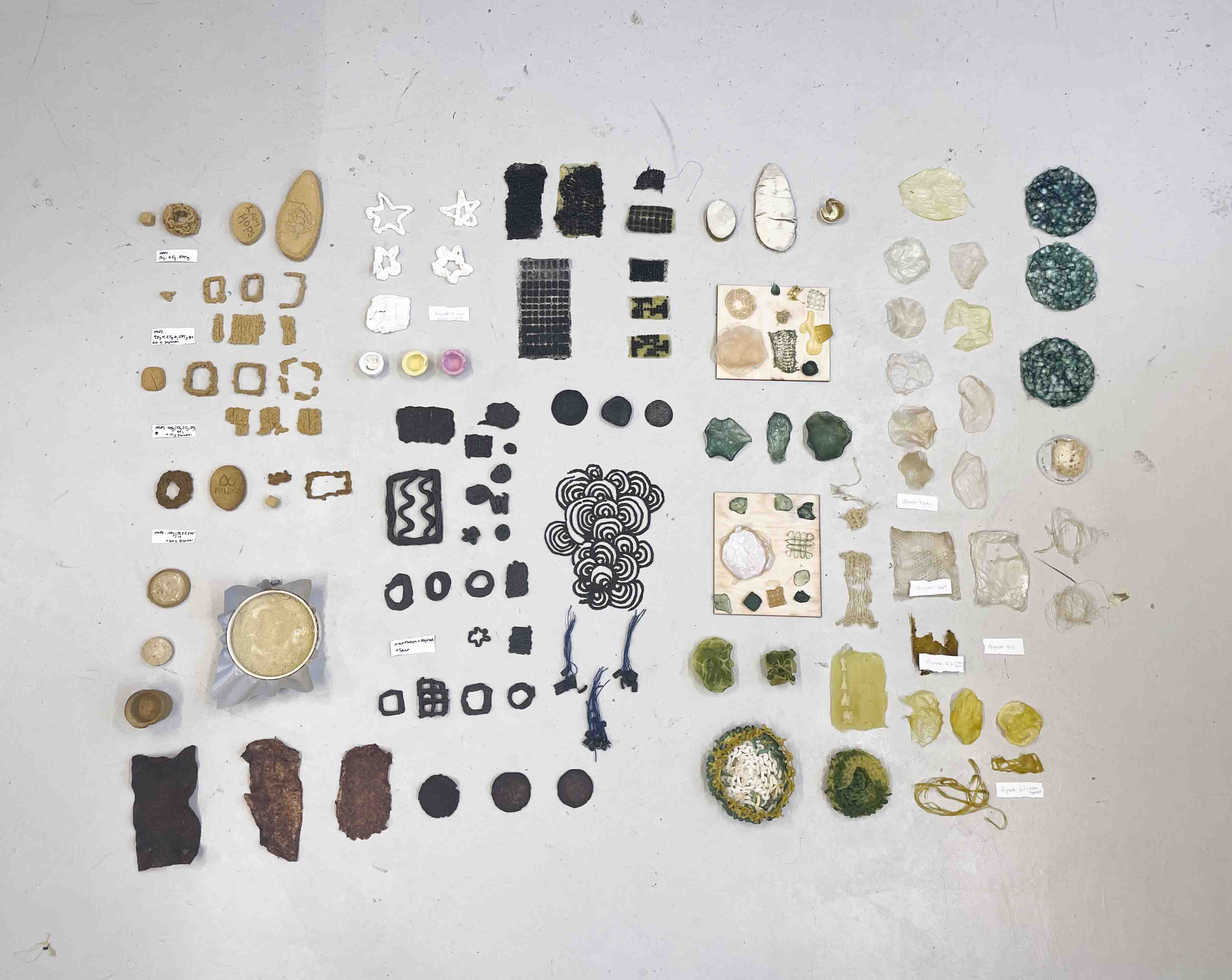
- 01| SAMPLES OF ALGINATE MATERIALS, PHOTO BY ALBERTE BOJESEN
THE ICELANDIC BIO-MATERIALS CHRONICLES can also be seen here, code provided by Emma Shannon.
GOOD TO KNOW | GELATIN¶
Gelatine based bioplastics are based on collagen derived from animal parts. In a world where we eat meat it makes sense to use the other parts of the animals that we do not eat, such as the bones, hair and intestines. Collagen Hydrolysate is derived by treating skins, bones or fish scales with an acid or alkaline process. Gelatine gel can also be made at home by boiling the animal parts, creating the gel when cooled.
Prepare this recipe 1 by collecting the ingredients necessary, to be found in the list below:
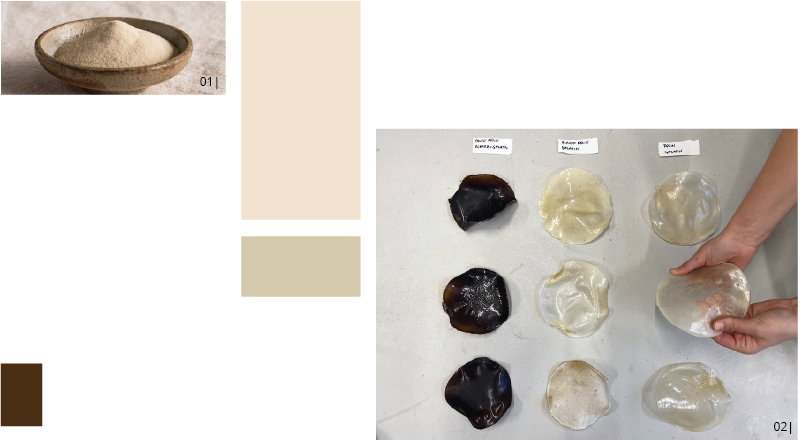
- 01| PHOTO OF GELATINE POWDER
- 02| GELATINE BIO-RESIN, PHOTO ALBERTE BOJESEN
THE ICELANDIC BIO-MATERIALS CHRONICLES: GELATINE can be seen here, code provided by Emma Shannon.
GOOD TO KNOW | AGAR¶
Agar or Agar-agar is a gel-like polysaccharide composed of agarose and agaropectin, which is derived from the cell walls of specific red algaes, Rhodophyceae. It originates from Japan and has been used there since around 1650 and was introduced in Europe in approximately 1859. During this time it was mainly used in the food industry, and still is today.
Prepare this recipe 1 by collecting the ingredients necessary, to be found in the list below:
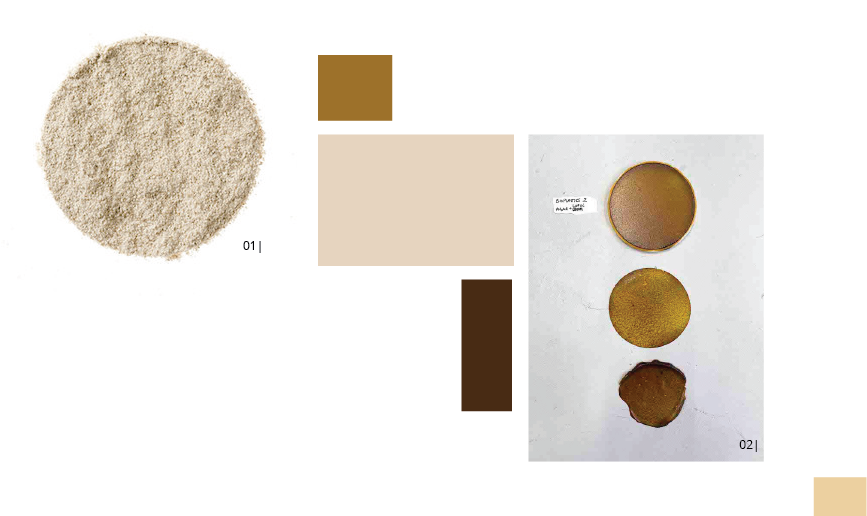
- 01| PICTURE OFAGAR-AGAR
- 02| AGAR BIO-PLASTIC 2, PHOTO ALBERTE BOJESEN
THE ICELANDIC BIO-MATERIALS CHRONICLES: AGAR can be seen here, code provided by Emma Shannon.
Work From The Icelandic Node, Fabricademy, 2022.
GOOD TO KNOW | ALGINATE¶
Sodium alginate is another polysaccharide of alginic acid and gum derived from the cell walls of brown algae. Working with alginate for fabricating bio-plastics is different from working with the gelatine of the agar, where you add heat to dissolve and jellify the powders. For sodium alginate you do not need heat but a curing solution of sodium chloride hydrate and water. The Alginate is first mixed in a water glycerol solution with a mechanical mixer, left overnight to set and then placed on a surface sprayed with the sodium chloride hydrate solution, thereafter the alginate solution is sprayed with the same solution to cure and solidify. The amount of curing time affects how cured the material becomes. Thereafter the alginate material should be rinsed in water.
Prepare this recipe 1 by collecting the ingredients necessary, to be found in the list below:
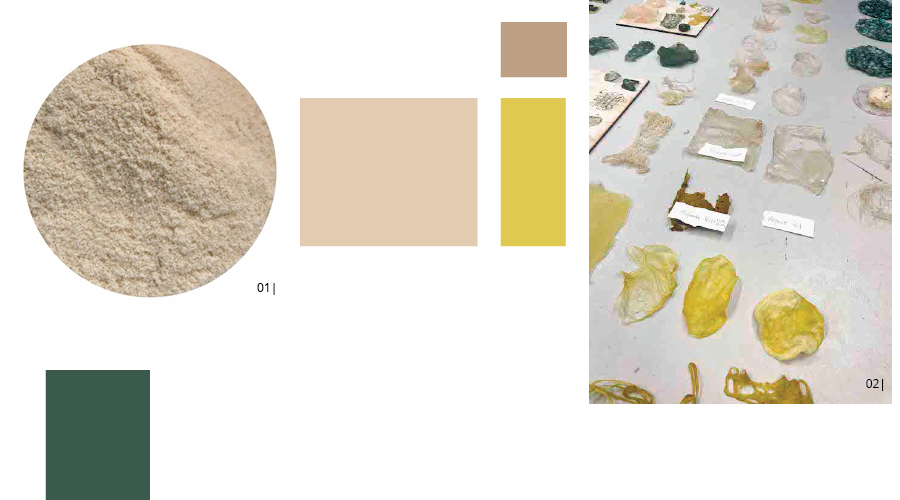
- 01| PICTURE OF SODIUM ALGINATE
- 02| ALGINATE BIO-MATERIAL SAMPLES, PHOTO ALBERTE BOJESEN
THE ICELANDIC BIO-MATERIALS CHRONICLES: ALGINATE can be seen here, code provided by Emma Shannon.
GOOD TO KNOW | HOPS¶
The hops delivered to us by Emma Shannon are a waste product from the beer production of a local brewery here in Iceland. Due to the hops' density we tried to make 3D print paste of the hops so Emma and I prepared different alginate recipes for making hops print paste. This, however did not go very well, as the hops paste became very porous and worked the best when pressed together. Emma later continued this research with other recipes which worked better.
Prepare this recipe 1 by collecting the ingredients necessary, to be found in the list below:
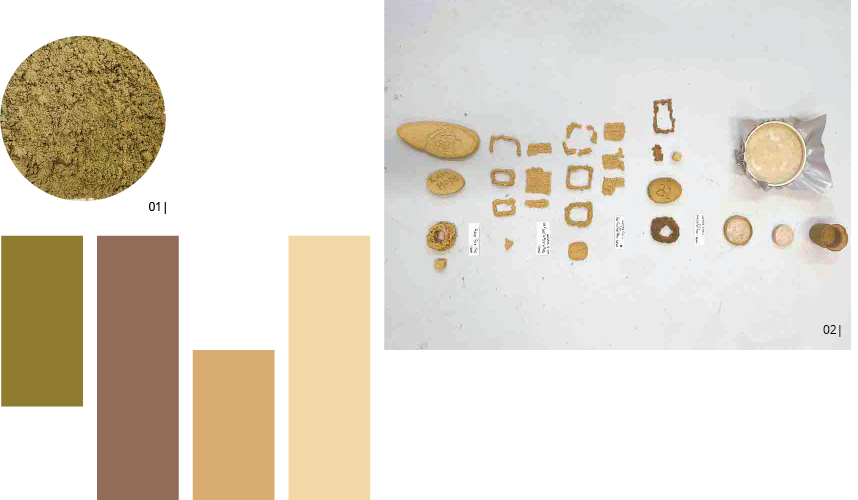
- 01| PICTURE OF HOPS FROM A LOCAL BREWERY, PROVIDED BY EMMA SHANNON
- 02| HOPS BIO-MATERIAL SAMPLES, PHOTO ALBERTE BOJESEN
THE ICELANDIC BIO-MATERIALS CHRONICLES: HOPS can be seen here, code provided by Emma Shannon.
GOOD TO KNOW | FISH SCALES¶
The fiscales were provided by Nordic Fishleather, as it is a waste product of their leather production. We received the scales and rinsed them in warm water with some detergent in to clean off the worst of the meat left on the scales. Thereafter the scales were rinsed with cold water and dried on nets. We tried grinding the scales down in a coffee grinder and a mixer, which took a long time, as the scales turned out to be very hard. The ground scales were put into a gelatine bio plastic which had a very nice translucency. I also tried to put the whole scales into an alginate mixture with spirulina, which also had an interesting translucency and feeling, but it is also very rigid.
Prepare this recipe 1 by collecting the ingredients necessary, to be found in the list below:

- 01| PICTURE OF HOPS FROM NORDIC FISHLEATHER, PROVIDED BY [EMMA SHANNON]((https://class.textile-academy.org/2023/emma-shannon/), PHOTO EMMA SHANNON
- 02| FINELY GROUND FISHSCALE GELATINE BIO-PLASTIC SAMPLES, PHOTO ALBERTE BOJESEN
- 03| FISHSCALE ALGINATE BIO-FOIL WITH SPIRULINA, PHOTO ALBERTE BOJESEN
- 04| BOILED FISHSCALE GELATINE BIO-PLATIC SAMPLES, PHOTO MARGRÉT GUTTORMSDÓTTIR
THE ICELANDIC BIO-MATERIALS CHRONICLES: FISHSCALES can be seen here, code provided by Emma Shannon.
I am quite interested in using the scales, as they are a waste product and are derived locally in the next town over. However I need to make more samples to master the material better. The next step would be to try it as a thin layer in the alginate, gelatine and agar, and then try to grind/ cut it down in different ratios. I think it would work very well as a contrast to the black sand.
GOOD TO KNOW | SEAWEED¶
The seaweed we collected for 04 | BIOCHROMES were here used as a filler material in the alginate bioplastic recipe. The seaweed we can find here is Fucus Serratus, and I found it to be much harder to grind down than the Kombu seaweed. I decided to use the same recipe for preparing the paste as my previous work with making seaweed paper of Kombu. And then using the paste to fill in the alginate, I attempted two different ratios, and later tried to add more water and glycerol, but it was very hard to work with.
Prepare this recipe 1 by collecting the ingredients necessary, to be found in the list below:
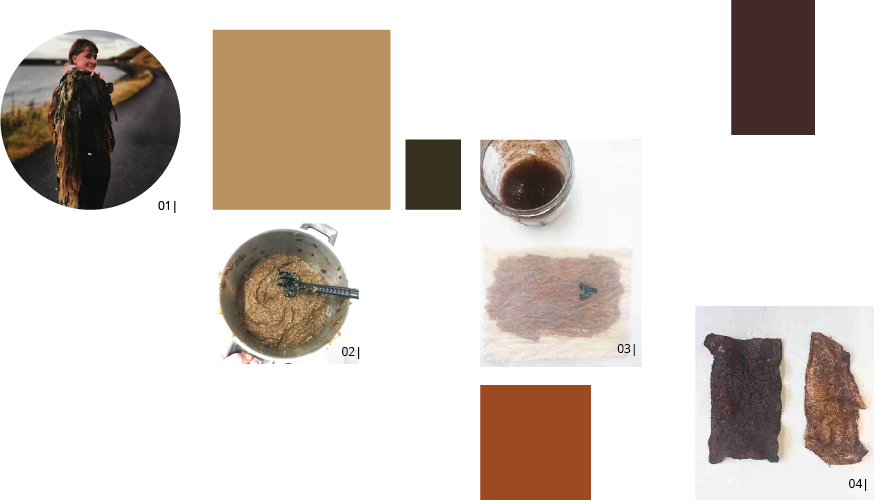
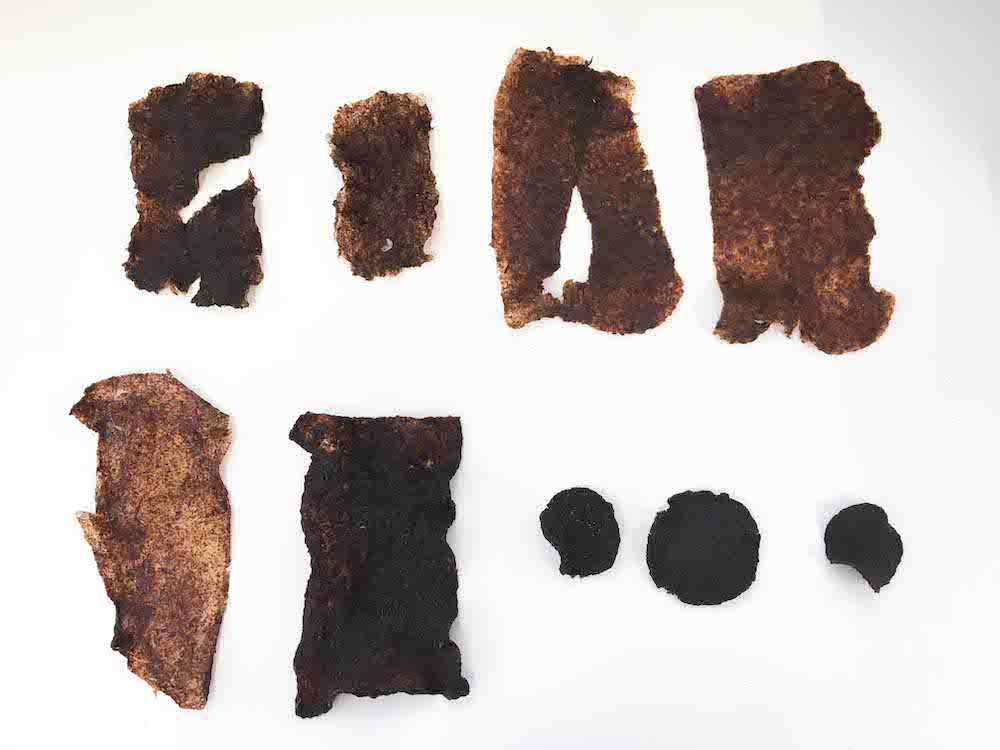
- 01| LOCAL SEAWEED FUCUS SERRATUS, PHOTO EMMA SHANNON
- 02| BOILED AND MIXED FUCUS SERRATUS, PHOTO ALBERTE BOJESEN
- 03| HIGHER CONCENTRATION OF GLYCEROL ALGINATE SAMPLE IN FABRIC, PHOTO ALBERTE BOJESEN
- 04| FUCUS SERRATUS ALIGNATE SAMPLES, PHOTO ALBERTE BOJESEN
- 05| FUCUS SERRATUS ALGINATE ON CURING IN THE MOULD, PHOTO ALBERTE BOJESEN
- 06| FUCUS SERRATUS ALGINATE SAMPLES AFTER 2 WEEKS, PHOTO ALBERTE BOJESEN
| SAMPLE | AMOUNT OF FUCUS SERRATUS | AMOUNT OF GLYCEROL | DESCRIBTION |
|---|---|---|---|
| TOP LEFT | 550g | 30g | CRACK WHEN MOVED THE SEAWEED DOES NOT STICK TOGETHER |
| TOP MIDDLE LEFT | 150g | 30g | ONE OF THE BETTER SAMPLES |
| TOP MIDDLE RIGHT | 250G | 40g | VERY WET |
| TOP RIGHT | 250G | 50g | VERY WET |
| BOTTOM LEFT | 150g | 30g | VERY THIN LAYER, NICE TRANSLUCENCY BUT FRAGILE |
| BOTTOM MIDDLE RIGHT | 250 g | 30g | MOULDED SAMPLE, VERY HARD AND UNDEFINED |
| BOTTOM MIDDLE | ONLY SEAWEED PASTE, NO ALGINATE | FROM THE BOILING | HARD |
| BOTTOM MIDDLE RIGHT | 250 g | 30g | HARD |
| BOTTOM RIGHT | 150g | 30g | HARD |
The alginate seaweed curled up a lot and is not very flexible, the samples with more glycerol became very wet to the touch. The Bottom middle left sample was made using the organic mould pattern, but when dried it cannot be seen. Thus I think I need to look into working with agar and gelatine, to avoid the shrinkage, and get the translucency. This local Fucus Serratus is very hard to work with, as it is hard to grind down to an even paste, and it gets a very weird brown reddish colour. The colour is nice if it is more translucent, which I think I can achieve with the use of agar and gelatine. I really want to continue my work with seaweed as it is an amazing material and also an alternative source, see the article from the European Union.
GOOD TO KNOW | BLACK SAND¶
Here in Iceland we have the most beautiful black sand beaches due to the volcanic activity around the island. One of the first things I was told when I came here was that there is a white-sand beach here, the Natuhólsvík Geothermal beach, where the sand is imported from Morocco. That just sounded so comical to me, that we import sand to have the "correct" colour on the beach, it goes against all my local-focused and ecocentric values, especially when the black sand is so beautiful. Therefore I wanted to see how this sand functioned as a filling material in order to harness its dark beauty.
Prepare this recipe 1 by collecting the ingredients necessary, to be found in the list below:


- 01| LOCAL BLACK SAND BEACH, PHOTO ALBERTE BOJESEN
- 02| SAND SHADE 3 AND LUPIN ALGINATE SQUARE RELIEF, PHOTO ALBERTE BOJESEN
- 03| SAND SHADE 3, 2, 1 ALGINATE, PHOTO ALBERTE BOJESEN
- 04| SAND SHADE 3 ORGANIC RELIEF, PHOTO ALBERTE BOJESEN
- 05| SAND ALGINATE SAMPLES, PHOTO ALBERTE BOJESEN
- 06| GIPH OF ORGANIC RELIEF SAND SHADE 3, PHOTO ALBERTE BOJESEN
- 07| GIPH OF SQUARED RELIEF SAMPLES, PHOTO ALBERTE BOJESEN
- 08| GIPH OF RECTANGULAR RELIEF SAND SHADE 3,2,1, PHOTO ALBERTE BOJESEN
- 09| GIPH OF ORGANIC RELIEF SAND SHADE 3 WITH LUPIN BACKING, PHOTO ALBERTE BOJESEN
- 10| BLACK SAND ALGINATE SAMPLES AFTER 2 WEEKS, PHOTO ALBERTE BOJESEN
| SAMPLE | ALGINATE IN MOULD | ALGINATE IN BACKING | DESCRIBTION |
|---|---|---|---|
| TOP LEFT | SHADE 3 | SHADE 1 | THE BACKING DRIED UP ALOT, WOULD NEED MORE GLYCEROL. |
| TOP MIDDLE LEFT | SHADE 3 | ALGINATE FLEXIBLE BIO FOIL WITH LUPIN PIGMENT | DRIED UP AND IS VERY UN-FLEXIBLE. |
| TOP MIDDLE RIGHT | SHADE 3, SHADE 2, SHADE 1 | SHADE 1 | THE BACKING DRIED UP ALOT, WOULD NEED MORE GLYCEROL. |
| BOTTOM LEFT | SHADE 1 | DRIED UP | |
| BOTTOM MIDDLE | SHADE 2 | DRIED UP | |
| BOTTOM MIDDLE RIGHT | SHADE 3 | QUITE FLEXIBLE | |
| TOP RIGHT 01 | SHADE 2 | ALGINATE FLEXIBLE BIO FOIL WITH LUPIN PIGMENT | DRIED UP AND IS VERY UN-FLEXIBLE. |
| RIGHT 02 | SHADE 3 | ALGINATE FLEXIBLE BIO FOIL WITH LUPIN PIGMENT | DRIED UP AND IS VERY UN-FLEXIBLE. |
| RIGHT 03 | SHADE 3 | ALGINATE FLEXIBLE BIO FOIL WITH LUPIN PIGMENT | DRIED UP AND IS VERY UN-FLEXIBLE. |
| RIGHT 04 | SHADE 3 | SHADE 1 | DRIED UP AND IS VERY UN-FLEXIBLE. |
| RIGHT BOTTOM 05 | SHADE 3 | SHADE 3 | DRIED UP AND IS VERY UN-FLEXIBLE. |
The sand functioned very well as a filler as it is quite porous and therefore absorbs liquid slightly, but as it is sand it also does not allow the bio-plastic alginate to shrink as much. This is a very interesting property as it allows for very sharp and defined moulds. However the alginate based plastics might be better to be exchanged by an agar or gelatine based plastic, as the samples ended up becoming quite fragile and cracks easily. This might also be prevented by adding more glycerol. The gradation in colour one can get by playing with the amount of sand is also really interesting. The next step is to see how the sand works with the other bio-based plastics and how the moulds work with these materials.
GOOD TO KNOW | KOMBUCHA¶
Kombucha is a grown bio-material i.e. it can be seen as a leather. We started out kombucha, Karen, already in the first week of the fabricademny. She moulded a bit because we did not make her acidic enough, however we managed to get two thin samples out of her.
Prepare this recipe 1 by collecting the ingredients necessary, to be found in the list below:

- 01| PICTURE OF SCOBY
- 02| TEABAGS IN BOILED WATER FOR KOMBUCHA STARTER, PHOTO ALBERTE BOJESEN
- 03| DRIED KOMBUCHA, PHOTO MARGRÉT GUTTORMSDÓTTIR